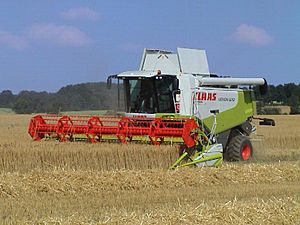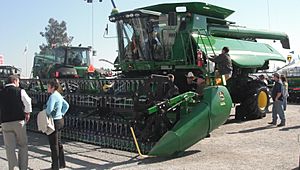Combine harvester facts for kids

The modern combine harvester, or simply combine, is a versatile machine designed to efficiently harvest a variety of grain crops. Its name comes from doing three separate parts of harvesting crops at once:
- reaping: cutting and collecting crops when they are ready for harvesting,
- threshing: separating the parts of a crop that can be eaten by people from the parts that can't, and
- winnowing: removing the already separated parts of the crop that can't be eaten by people, the chaff, while keeping the part that can be eaten, the grain.
Among the crops harvested with a combine are wheat, oats, rye, barley, corn (maize), sorghum, soybeans, flax (linseed), sunflowers, and canola. The waste straw left behind on the field is the remaining dried stems and leaves of the crop with limited nutrients which is either chopped and spread on the field or baled for feed and bedding for livestock.
Combine harvesters are one of the most economically important labour saving inventions, significantly reducing the fraction of the population that must be engaged in agriculture. Far fewer people work in farming as a result of the combine harvester.
History
In 1826 in Scotland, the inventor Reverend Patrick Bell designed (but did not patent) a reaper machine, which used the scissors principle of plant cutting – a principle that is still used today. In 1835, Moore built a full-scale version. This combine harvester was pulled by 20 horses fully handled by farmhands.
By 1860, combine harvesters with a cutting, or swathe, width of several meters were used on American farms. Australian Hugh Victor McKay produced a commercially successful combine harvester in 1885, the Sunshine Harvester.
Combines, some of them quite large, were drawn by mule or horse teams and used a bullwheel to provide power. Later, steam power was used, and George Stockton Berry integrated the combine with a steam engine using straw to heat the boiler. At the turn of the twentieth century, horse drawn combines were starting to be used on the American plains and Idaho (often pulled by teams of twenty or more horses).
In 1911, the Holt Manufacturing Company of California produced a self-propelled harvester. In Australia in 1923, the patented Sunshine Auto Header was one of the first center-feeding self-propelled harvesters. A significant advance in the design of combines was the rotary design. Rotary combines were first introduced by Sperry-New Holland in 1975.
In about the 1980's on-board electronics were introduced to measure threshing efficiency. This new instrumentation allowed operators to get better grain yields by optimizing ground speed and other operating parameters.
Images for kids
-
Allis-Chalmers GLEANER L2
-
John Deere Combine harvesters being transported by railway on flat cars in Tyrone, Pennsylvania, in the United States.
See also
 In Spanish: Cosechadora para niños
In Spanish: Cosechadora para niños

















